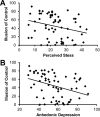Perceived Stress, Anhedonia and Illusion of Control: Evidence for Two Mediational Models
- PMID: 23798772
- PMCID: PMC3689309
- DOI: 10.1007/s10608-011-9413-8
Perceived Stress, Anhedonia and Illusion of Control: Evidence for Two Mediational Models
Abstract
Illusion of control (IOC) refers to the perception that one has control over an outcome, that is, in actuality, uncontrollable; low IOC has been linked to depression. Prior studies in depression have mostly assessed IOC using paradigms involving positive outcomes, suggesting that IOC might be influenced by anhedonia. Recent evidence indicates that anhedonia, in turn, is linked to stress. To clarify such links, we examined putative relationships among perceived stress, anhedonia, and IOC (as assessed by a non-contingency task) in 63 participants. Perceived stress and anhedonia, but not general depressive symptoms, were associated with reduced IOC. Moreover, anhedonia fully mediated the relationship between stress perception and IOC, and perceived stress partially mediated the relationship between IOC and anhedonia. Findings suggest that (1) IOC is integrally related to hedonic capacity, (2) reward processing deficits may promote reduced IOC, and/or (3) a low IOC may promote depression via anhedonia-related mechanisms.
Keywords: Anhedonia; Depression; Illusion of Control; Reward; Stress.
Figures


References
-
- Alloy LB, Abramson LY. Judgment of contingency in depressed and nondepressed students: Sadder but wiser? Journal of Experimental Psychology. 1979;108:441–485. - PubMed
-
- Alloy LB, Clements CM. Illusion of control: Invulnerability to negative affect and depressive symptoms after laboratory and natural stressors. Journal of Abnormal Psychology. 1992;101:234–245. - PubMed
-
- Anisman H, Matheson K. Stress, depression, and anhedonia: Caveats concerning animal models. Neuroscience and Biobehavioral Reviews. 2005;29:525–546. - PubMed
-
- Baron RM, Kenny DA. The moderator-mediator variable distinction in social psychological research: Conceptual, strategic and statistical considerations. Journal of Personality and Social Psychology. 1986;51:1173–1182. - PubMed
-
- Beck AT, Steer RA, Brown GK. Beck Depression Inventory Manual. 2nd ed. The Psychological Corporation; San Antonio, Texas: 1996.
Grants and funding
LinkOut - more resources
Full Text Sources
